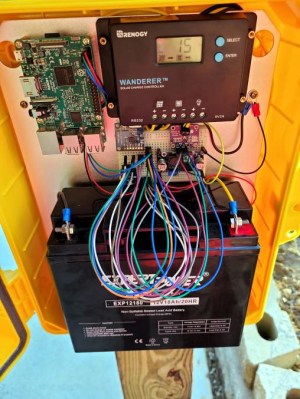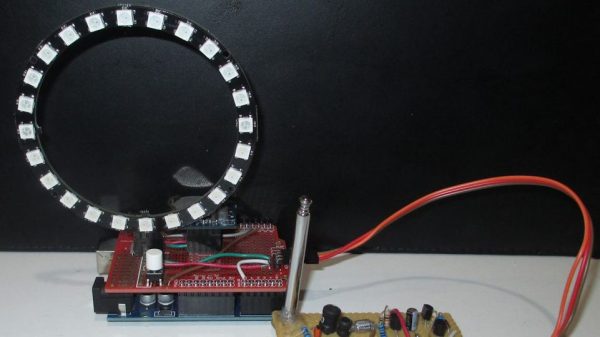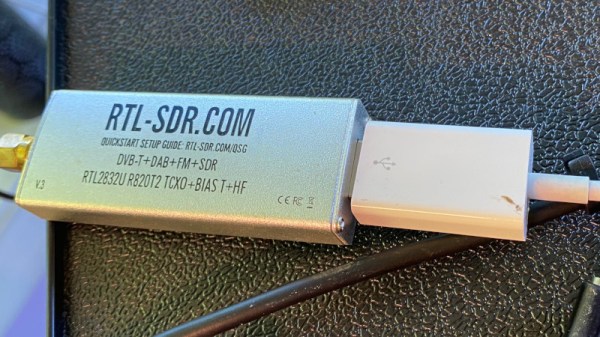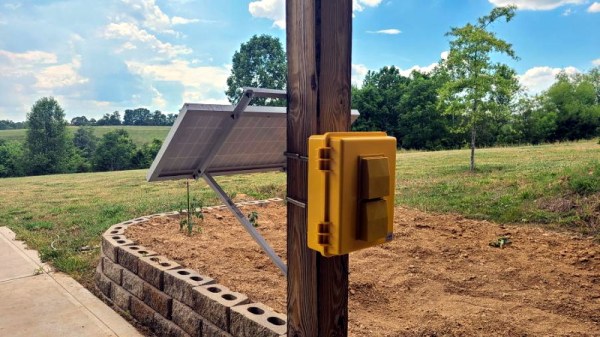For as mysterious, fascinating, and beautiful as lightning is at a distance, it’s not exactly a peaceful phenomenon up close. Not many things are built to withstand millions of volts and tens to hundreds of thousands of amps. Unsurprisingly, there’s a huge amount of effort put into lightning protection systems for equipment and resources that need to be outside where thunderstorms sometimes happen. Although most of us won’t be building personal substations, church steeples, or city-scale water towers in our backyards, we might have a few radio antennas up in the air, so it’s a good idea to have some lightning protection and possibly an alert system like [Joe] built.
lightning detector13 Articles
A Collection Of Lightning Detectors
You would think detecting lightning would be easy. Each lightning bolt has a staggering amount of power, and, clearly, you can hear the results on any radio. But it is possible to optimize a simple receiver circuit to specifically pick up lightning. That’s exactly what [Wenzeltech] shows in a page with several types of lightning detectors complete with photos and schematics.
Just as with a regular radio, there are multiple ways to get the desired result. The first circuits use transistors. Later versions move on to op amps and even have “storm intensity” meters. The final project uses an ion chamber from a smoke detector. It has the benefit of being very simple, but you know, also slightly radioactive.
You might think you could detect lightning by simply looking out the window. While that’s true, you can, in theory, detect events from far away and also record them easily using any data acquisition system on a PC, scope, or even logic analyzer.
Why? We are sure there’s a good reason, but we’ve never needed one before. These designs look practical and fun to build, and that’s good enough for us.
You can spruce up the output easily. You can also get it all these days, of course, on a chip.
Lightning Detector Keeps A Tally
Lightning is one of the great forces of nature. The huge releases of electricity release detectable electromagnetic emissions, as you might expect. The team at the [LVL1 Hackerspace] put together a lightning detector of their own; one which keeps count of the number of discharges in the atmosphere.
The device consists of a typical tank circuit tuned to 300kHz, paired with a small telescopic antenna. Lightning strikes in the area induce an oscillation in the circuit which is amplified and then detected by an Arduino. The Arduino measures the voltage of the pulse, which is proportional to the magnitude of the signal detected. A ring of Neopixel LEDs are then switched on relative to the intensity of the signal. Additionally, when not actively detecting strikes, the Arduino instead uses the LEDs to display the current time and a binary count of the number of strikes detected since it has been running.
It’s a simple build, and one that would serve as a great introduction into the world of addressable LEDs and environmental monitoring. If you’d like to go about it another way, you can detect lightning with an SDR, too!
Lightning Analysis With Your SDR
Perhaps it’s just one of those things adults dream up to entertain their children, but were you ever told to count slowly the time between seeing a lightning flash and hearing the rumble of thunder? The idea was that the count would tell you how far away the storm was, but from a grown-up perspective the calibration accuracy of a child saying “one… two…three…” in miles seems highly suspect. It’s a valid technique though, and it can be used to monitor thunderstorms by the radio emissions created through the electrical discharge. It’s an area the SAGE project has been working in, and they’ve posted some details including a fascinating run-down of the software techniques , on how lightning can be detected with an RTL-SDR.
A lightning strike produces a characteristic wideband burst that shows up in the time domain as a maximum point that can easily be detected but could also be confused with radio interference from another source. Thus after identifying maxima they zoom in and perform a Fourier transform to spot the wideband burst. It’s all done in Python, and the pleasant surprise is how straightforward to understand it all is.
SAGE are working on a distributed sensor network, so we hope this work might one day give us real-time open lightning data. The FFT approach should ensure that it won’t be fooled by false positives as a traditional detector might be.
Via RTL-SDR.com.
Solar Weather Station Listens For Lightning
Custom weather stations are a common enough project these days, especially based around the ESP8266. Wire a sensor up to the MCU, power it up with an old phone charger, and you’re half way there. But if you want something that’s going to operate remotely on the long term, you’ve got to put a little more thought into it.
 Which is exactly what [BuckarewBanzai] did for his solar powered Raspberry Pi weather station. With an industrial NEMA-rated enclosure, a beefy 35 watt photovoltaic panel, and enough lead-acid battery capacity to keep the show going for days, this build is certainly more robust than most. Some might call it overkill, but we think anyone who’s ever deployed hardware outdoors for more than a few days knows you can never be too careful when Mother Nature is involved.
Which is exactly what [BuckarewBanzai] did for his solar powered Raspberry Pi weather station. With an industrial NEMA-rated enclosure, a beefy 35 watt photovoltaic panel, and enough lead-acid battery capacity to keep the show going for days, this build is certainly more robust than most. Some might call it overkill, but we think anyone who’s ever deployed hardware outdoors for more than a few days knows you can never be too careful when Mother Nature is involved.
To keep the 18 Ah battery topped off, [BuckarewBanzai] is using a 10 amp Wanderer charge controller. It sounds as though he burned through a few lesser models before settling on this one; something to consider for your own off-grid projects. An LM2596 regulator is then used to provide a stable 5 V for the Raspberry Pi.
In addition to the BME280 environmental sensor that picks up on temperature, humidity, and pressure, there’s also a AS3935 lightning sensor onboard which [BuckarewBanzai] says can pick up strikes up to 40 kilometers away. All of this environmental data is collected and stored in a local SQLite database, and gets pushed offsite every five minutes with a REST API so it can be visualized with Grafana.
Critics in the audience will no doubt pick up on the solderless breadboard located in the center of the weather station, but [BuckarewBanzai] says he’s already on the case. He’s working on a custom PCB that will accept the various modular components. Not only should this make the station more reliable, but he says it will cut down on the “spaghetti” wiring. Though for the record, this is hardly the worst offender we’ve seen in that department.
Hackaday Podcast 039: Elliot <3 Lightning Detectors, Ikea Dark Mode, The Smartest Watch, Solar Sailing The Sky, And VAWT Controversy
Hackaday Editors Elliot Williams and Mike Szczys recap a week full of hacks from the solar sailing RC plane that has zero power storage, to geeking out about lightning detectors and hacking Ikea LED controllers to unlock real dimming to building backyard wind turbines. We look up an IoT egg tray with appreciation not for the concept but certainly for the engineering, and scratch our heads on why one-hacker-smartwatch-to-rule-them-all seems like something that should happen but so far has only been a fleeting concept.
Take a look at the links below if you want to follow along, and as always tell us what you think about this episode in the comments!
Take a look at the links below if you want to follow along, and as always, tell us what you think about this episode in the comments!
Direct download (60 MB or so.)
This Lightning Detector Is Remarkably Sensitive
Lightning strikes are quite high energy events, and release plenty of radio frequency energy when they go off in the atmosphere. This makes them easy to detect, and the magnitude of the energy release means it can be done at impressive range. [Jay] decided to build a device of his very own, and was impressed at its detection performance.
The device is a simple but effective design. An antenna is used to capture RF signals, and these are then amplified through a single transistor stage. This is connected to a basic transistor flasher circuit, which is biased to only flash when tipped over the edge by an incoming signal. After building the circuit, [Jay] noticed that the device wasn’t just picking up signals from lightning, but also those from many other smaller discharges. The device was able to detect a shock from wearing socks on a wood floor, as well as discharges from a Van de Graff generator and even just from getting out of a chair!
Lightning detectors have been around for a long time now; we’ve seen others grace these pages before. Video after the break.
Continue reading “This Lightning Detector Is Remarkably Sensitive”

















